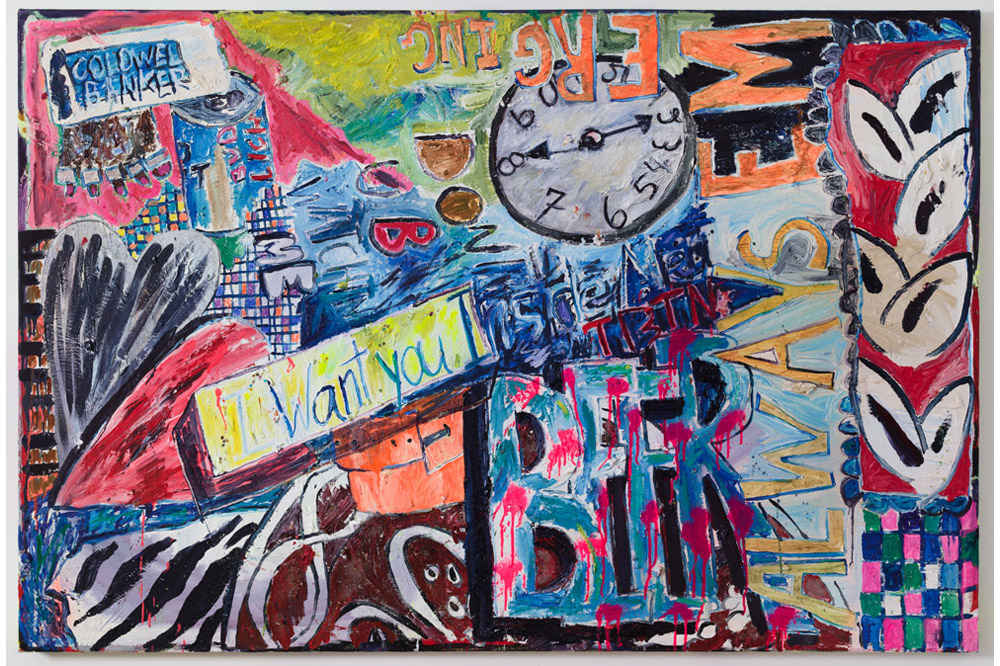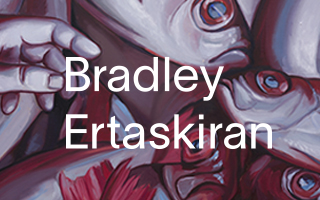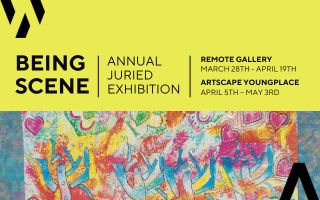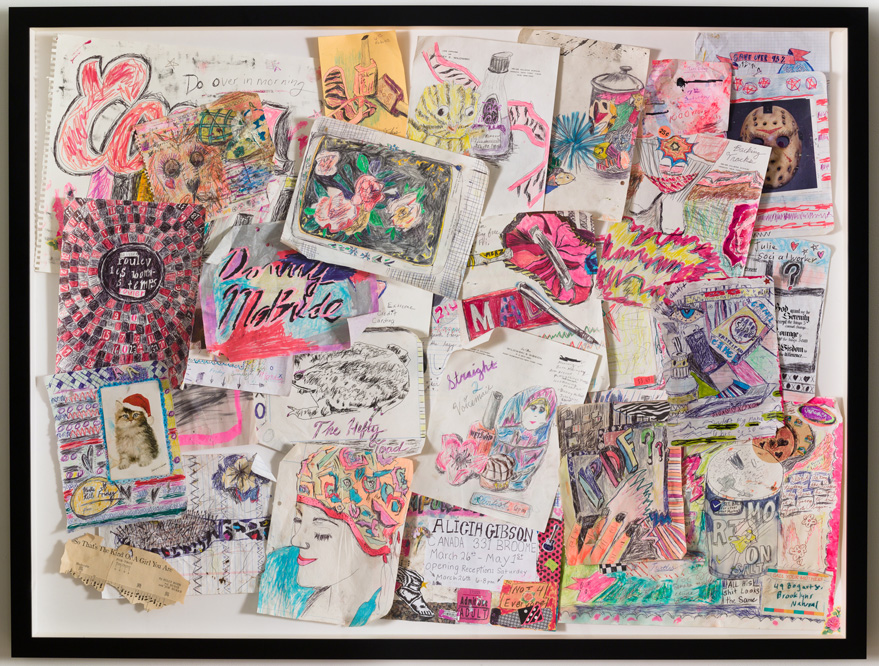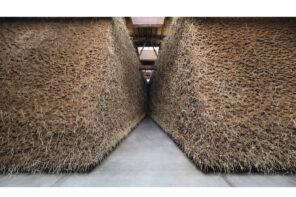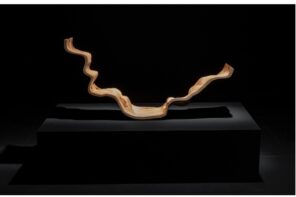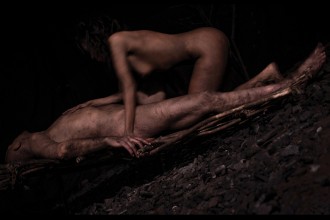A blind date is unfolding at Canada Gallery, in Alicia Gibson’s painting My Mom Set Me Up With a Redneck (2016). If, like me, you haven’t seen many “rednecks” hanging out in contemporary art galleries, you may catch a whiff of downward sneer in this title (or the lesser assault, “what was her mom thinking?”) While the title offers narrative clarity, the painting is an outburst of discontinuous phrase and motif – a combination that nicely sums up Purgatory Emporium’s perplexing charm. Resiliently incoherent, Gibson’s paintings recombine class and intimate experience. It’s tempting to believe that angst must be at the heart of this show, which often resembles so many hyperbolic journal entries. Actually, Gibson performs through her paintings as a canny automatic writer, coyly dangling the matter of the heart over the purgatory of cliché.
Without visual evidence in My Mom Set Me Up… of a date or a redneck, the painting’s title is quickly challenged by its physical appearance, which more closely approximates a melange of conflicting memories. Anyone acquainted with the masochistic ritual of establishing familial history over Sunday dinner will understand this feeling well. It’s hardly surprising, then, that the painting, made of oil, spray paint, fake fur, and various unlisted materials, also makes reference to the pharmaceutical mediation of stress; a cloud of violet and turquoise roils between the following densely clustered fragments: “ANGST…RX 1403928ON Gibson Alicia… clonazepam NO REFILLS… rollin… HE WAS ASKIN 4 IT…”. Drawing our attention back to dread-inducing family routines are a wide-eyed bunny, Santa Claus, and the patterning of a board-game. Gibson synthesizes her psychological bric-a-brac into visual chatter, captivating in its braiding of linguistic play and somatic heft.
The pitch rises towards anger in a thick, stormy painting titled Sorry I’m Not a Blonde Gallerist, Asshole (2015). Front and center against this backhanded apology is a small white dog, which sits on a black platter garnished with bilious green and garish pink. Although reminiscent of Dorothy’s Toto, the pup is depicted through a cracking mass of paint more akin to stale Pavlova than supple fur. Were it not for the cryptic suggestion of two eyes and a nose made by three black daubs in an adjoining deposit of white, there would be no dog to speak of. Here, the painting’s title is still discordant with its insides, but has been jotted, crammed, smeared out and re-written into the margins, with the word “sorry” half-obscured by a counterfeit hundred-dollar bill – phony payola earmarked for contemporary art’s sham meritocracy. Sorry I’m Not a Blonde Gallerist is not a forthright riposte to the artworld’s sexism. Nor is Gibson using her knack for mirroring psychological fervor to parody that critique, as is suggested by the work’s sarcastic undertone, deriving from the title’s impossible directness and the buffoonish absurdity of a plattered dog. She is doing both at once, generating crackling social and personal dissonances.
Calling up class as much as sex, and revering color and compositional structure as much as disdaining social decorum, these paintings approximate psychological compost. They’re given acidic bite through Gibson’s courting of a dark desire to peruse economic and cultural regions of America distinctly alien to the sanctified milieu of contemporary art. Having dismissed the blonde gallerist offhand, Gibson seems straightforwardly allergic to privilege. But does her own portrayal of another white lapdog in Poodle (2016) itself slip into elitist condescension? Groomed like a plush toy decorated with not one but two pink bows, and sitting lonely in a plane of bubble gum pink, this dog reminds us less of sophisticated Lower East Side gallerists than a stereotype of lowbrow vanity, easily scorned by cultural elites. In comparison to most of the paintings in this show, which appear as broken and re-jigged thought patterns, the poodle painting is visually idle, and seems about as invested in the conversation going on around it, as the dog it pictures. Still, a slow-burning tragedy emerges from the tangle of social and personal motives in which it’s implicated.
Gibson intuits a sophisticated understanding of the way that, through late-twentieth century painting, our desires for unfiltered disclosure have often been held up to a cruel mirror. Her show is shadowed by Louise Fischman‘s Angry Paintings (1973) – playfully acerbic text works on paper that spliced cartoonishly reductive images of feminist rage with the tangible threat of one’s identity disappearing into anger. Also lurking in the background are Lee Lozano‘s text-and-image pencil-crayon drawings of the 1960s, vibrant and rapid exhumations of bodily pathos, now sooted by Lozano’s refusal to speak to other women, and her eventual dropout from the artworld. Dangerously, this mythologized torment threatens to flood Gibson’s paintings. Were this to happen, though, it would not be her fault but ours; the representation of hysteria as an essentially female trait has long worked perniciously within art, cinema, and literature, producing a nasty familiarity with this oppressive image that in turn impels hack artists, filmmakers, and writers to give us more of what we know. As if wanting to negate this process without letting it out of sight, Gibson’s work is less frenzied confessional than searing auto-fiction – its dark comedy is effervescent.
Fortunately, the poodle’s torpor dissipates within a deluge of wickedly congested canvases, not to mention two large shadowboxes – both Untitled (2016) – containing dizzying accumulations of notational drawings: cascading cigarette boxes, the acronym PDF extruded into fluorescent block letters, roses scrawled into a frantic grey ground, a stuffed lion with a heart on its cheek, a black-and-white spotted toad named “The Hefty Toad,” and of course the obligatory kitty wearing a floppy Santa hat. Scuttling between the frenzy of mind maps and the bedazzled jazz of notebook doodles, these drawings are put down on cheap white paper, with materials available in any drugstore stationary aisle (pencil crayons, ball point pens, and neon highlighters). Piled atop one another, they form crescendos of interior monologue in low-fi hyper-color.
Purgatory Emporium’s blistering honesty is repeatedly counterpointed by a stifling self-consciousness. Watch What You Say to People, Nah Not Really (2015) suggests that this indecision is rooted in Gibson’s ambivalence regarding her subject matter. Here, the title phrase floats over floral fabric that, denim-blue, rose, and muddy chartreuse pulls us into the bedroom, or the linen closet. Barely legible, the title words hang on the picture plane like ghost murmurs. “Watch” is actually “WAT… WHA… WHATCH,” with the initial “WATC” translucent red like fluorescent ketchup, and flooding over the canvas’s upper half. These paintings study language as a cerebral and physical force always enmeshed with social circumstance, and it’s Gibson’s willingness to let the study become perverse that fascinates. It’s hard to forget that the person sipping a can of Coors Light – inferred in the painting Coors Light Flip Flops (2015) – either can’t afford anything better, or, as is often the case in New York’s artworld, is “slumming it.” Consider also the muddy implications of Gibson having misspelled the word “virgin” (as “virgun”) so that the second syllable stretches into a languid drawl (Virgin, 2016). This image brings to mind a high-school student who, by any number of circumstances – cognitive ability, class, race, geography – has been denied access to the interior mechanics of language.
Literally writ-large in dripping green and blue cursive on sloppy Pepto-Bismal pink, this “virgun” is decorated with yellow stars, a fake flower, and orange plastic chains, and bordered above and below by wobbling gridded stripes. In teenage life, the term “virgin” breaches the imagination, exerting pressure on the body. Here it is, tremulous like a tissue-paper banner for the dance. But Gibson’s impulsive drips and daubs reintroduce corporeal gravitas, so that whimsy and youthful psychosexual experience twitch against one another. In this context, another painting’s title – Good Times Ahead (2015) – reads like a nervous joke. Jotted in blue, these words lean lazily beneath the central motif of this painting, an ochre-yellow banana flecked with black, and thickly textured. Worries about the future dissipate into a day-glow aura.
“FUCK-EM” cruises over a skein of proto-expressive brushwork in another piece. But the painting’s title, Un Fuck Em (2015), throws this devil-may-care recklessness into reverse. The equivocating “UN” hangs high to the left – bruised mauve nearly disappearing into a slop of red. What is being un-fucked, here? A bad decision after a late night out? A professional relationship obliterated through a momentary failure of composure? In a painterly bait-and-switch, Gibson affects insouciance before revealing an earnest desire to wrest the past into a more tolerable image. Bubbly and tragicomic, Purgatory Emporium parrots the gawky reality of speech – an onerous coaxing of flubs and stammers from the rich juice of interior monologue. When Gibson’s own language dozes into flat-footed snickering – as in the poodle painting, and a comparable depiction of a Diet Coke can – it’s of little consequence; she’s produced a vacillating exhibition that leaves a critic sputtering after the right words.

